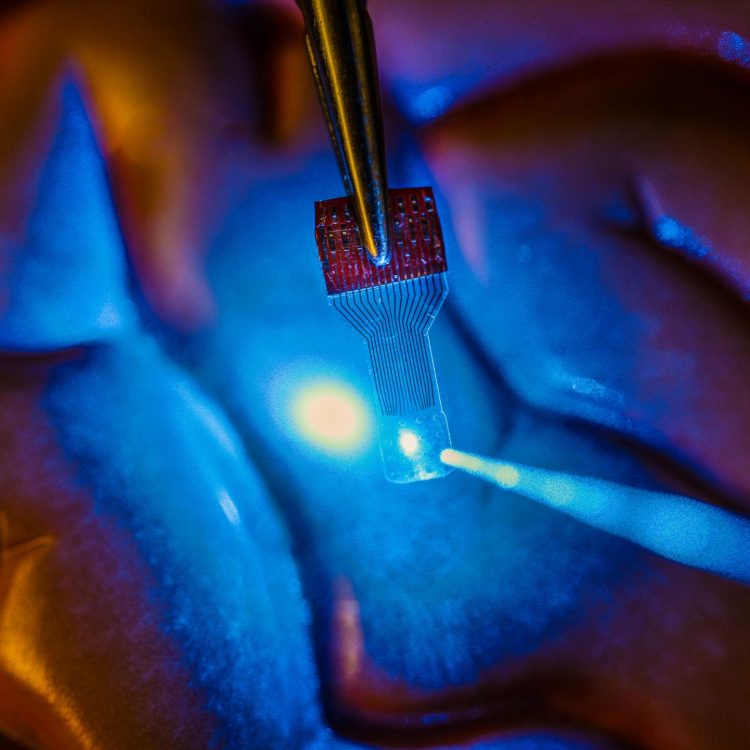Engineers reveal fabrication process for revolutionary transparent sensors

A blue light shines through a clear, implantable medical sensor onto a brain model. See-through sensors, which have been developed by a team of UW-Madison engineers, should help neural researchers better view brain activity. Credit: Justin Williams research group
Then the requests came flooding in. “So many research groups started asking us for these devices that we couldn't keep up,” says Zhenqiang (Jack) Ma, the Lynn H. Matthias Professor and Vilas Distinguished Achievement Professor in electrical and computer engineering at UW-Madison.
Ma's group is a world leader in developing revolutionary flexible electronic devices. The see-through, implantable micro-electrode arrays were light years beyond anything ever created.
Although he and collaborator Justin Williams, the Vilas Distinguished Achievement Professor in biomedical engineering and neurological surgery at UW-Madison, patented the technology through the Wisconsin Alumni Research Foundation, they saw its potential for advancements in research. “That little step has already resulted in an explosion of research in this field,” says Williams. “We didn't want to keep this technology in our lab. We wanted to share it and expand the boundaries of its applications.”
As a result, in a paper published Thursday (Oct. 13, 2016) in the journal Nature Protocols, the researchers have described in great detail how to fabricate and use transparent graphene neural electrode arrays in applications in electrophysiology, fluorescent microscopy, optical coherence tomography, and optogenetics. “We described how to do these things so we can start working on the next generation,” says Ma.
Now, not only are the UW-Madison researchers looking at ways to improve and build upon the technology, they also are seeking to expand its applications from neuroscience into areas such as research of stroke, epilepsy, Parkinson's disease, cardiac conditions, and many others. And they hope other researchers do the same.
“This paper is a gateway for other groups to explore the huge potential from here,” says Ma. “Our technology demonstrates one of the key in vivo applications of graphene. We expect more revolutionary research will follow in this interdisciplinary field.”
###
Funding for the initial research came from the Reliable Neural-Interface Technology program at the U.S. Defense Advanced Research Projects Agency. Other authors on the Nature Protocols paper include Dong-Wook Park, Sarah Brodnick, Jared Ness, Lisa Krugner-Higby, Solomon Mikael, Joseph Novello, Hyungsoo Kim, Dong-Hyun Baek, Jihye Bong, Kyle Swanson and Wendell Lake of UW-Madison; Farid Atry, Seth Frye and Ramin Pashaie of the University of Wisconsin-Milwaukee; Amelia Sandberg of Medtronic PLC Neuromodulation; Thomas Richner of the University of Washington; and Sanitta Thongpang of Mahidol University in Bangkok, Thailand.
Renee Meiller, meiller@engr.wisc.edu, (608) 262-2481
CONTACT: Zhenqiang (Jack) Ma, mazq@engr.wisc.edu, (608) 261-1095; or Justin Williams, jwilliams@engr.wisc.edu, (608) 265-3952
DOWNLOAD PHOTO: https:/
Media Contact
All latest news from the category: Power and Electrical Engineering
This topic covers issues related to energy generation, conversion, transportation and consumption and how the industry is addressing the challenge of energy efficiency in general.
innovations-report provides in-depth and informative reports and articles on subjects ranging from wind energy, fuel cell technology, solar energy, geothermal energy, petroleum, gas, nuclear engineering, alternative energy and energy efficiency to fusion, hydrogen and superconductor technologies.
Newest articles

High-energy-density aqueous battery based on halogen multi-electron transfer
Traditional non-aqueous lithium-ion batteries have a high energy density, but their safety is compromised due to the flammable organic electrolytes they utilize. Aqueous batteries use water as the solvent for…

First-ever combined heart pump and pig kidney transplant
…gives new hope to patient with terminal illness. Surgeons at NYU Langone Health performed the first-ever combined mechanical heart pump and gene-edited pig kidney transplant surgery in a 54-year-old woman…

Biophysics: Testing how well biomarkers work
LMU researchers have developed a method to determine how reliably target proteins can be labeled using super-resolution fluorescence microscopy. Modern microscopy techniques make it possible to examine the inner workings…





















